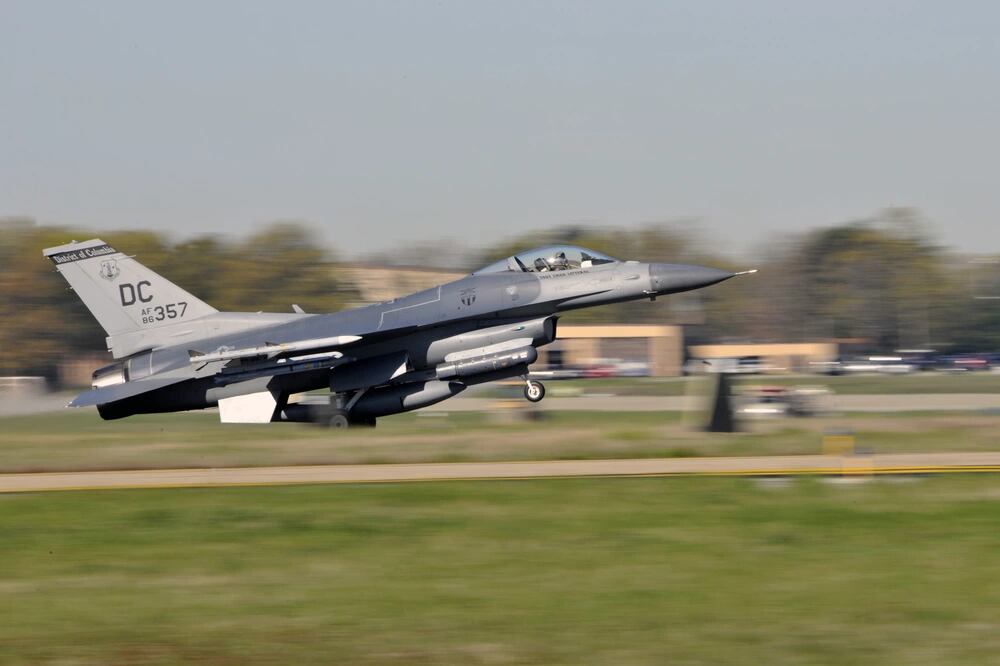Washington-area residents were startled Sunday afternoon when a D.C. Air National Guard F-16 fighter jet went supersonic in pursuit of an unresponsive Cessna business plane, letting loose a sonic boom that echoed across Maryland, Virginia and the District of Columbia.
The U.S. military routinely trains near the national capital region, practicing to intercept wayward aircraft and other threats along the East Coast. But those jets rarely break the sound barrier over land unless they face a real-world emergency, to prevent panic among unsuspecting residents on the ground and damage to the community around them.
Military pilots don’t need to zip around at supersonic speeds all the time; for instance, F-35A Lightning II pilots cruise around .9 Mach, or around 700 miles per hour.
Going faster than the speed of sound — around 760 miles per hour — helps pilots fire weapons smoothly in air-to-air combat training, such as those simulating offensive counter-air missions, said Heather Penney, a former F-16 Fighting Falcon pilot who now works as a defense policy expert at the Air and Space Forces Association’s Mitchell Institute for Aerospace Studies.
Penney said they are allowed to break the sound barrier in a limited number of scenarios: over the ocean or on a training range where it won’t disrupt everyday life, or in an emergency with a superior’s approval.
And it comes in handy when a pilot needs to catch up with an out-of-place or unresponsive aircraft, so they have more time alongside the plane to assess whether it is a threat or not, Penney said. Most often, she said, people simply get lost or don’t know where they’re allowed to fly.
On Sunday, the New York-bound Cessna Citation business jet suddenly turned around over Long Island, prompting the military to scramble six fighter jets to intercept it. Its civilian pilot appeared to be slumped over and unresponsive, U.S. officials told the Associated Press of their conversations with the fighter pilots. The officials were granted anonymity because they were not authorized to speak publicly about the military operation.
North American Aerospace Defense Command spokesman John Ingle told Military Times this week that one F-16 that responded to the unresponsive Cessna made the jump to supersonic speed, though three others were also authorized to do so.
Two F-16s tasked to NORAD’s homeland defense mission flew alongside the Cessna over Virginia around 3:20 p.m., the Pentagon said. Military Times staff heard the sonic boom echo over Washington roughly ten minutes earlier. It’s unclear at what point the jets sped up to catch the unresponsive plane, or how long they escorted it; Ingle said NORAD is still establishing the timeline of events.
The go-ahead to exceed Mach 1 comes from the U.S.-focused branch of NORAD, which is responsible for monitoring and defending the continent’s skies.
“NORAD aircraft typically fly at speeds slower than those required to create a sonic boom. However, that could change depending on the mission and the need to respond in such a manner to provide decision-makers the necessary time to act,” Ingle said. “NORAD aircraft often operate within specified parameters when over land so as to mitigate sonic boom disturbances.”
On top of considering where a sonic boom might reverberate the strongest, officials have to consider the threat level, the atmospheric conditions and how high the jet is flying before approving supersonic flight.
Once a jet breaks the sound barrier, the sonic boom fans out like the wake behind a boat. As with a boat’s wake, the compressed air of a sonic boom is strongest near the jet and gets weaker as it fans out behind the aircraft. That’s why people closer to the F-16 heard and felt its roar more intensely than those farther away, Penney said.
And the jet pilots don’t feel a sonic boom from the cockpit, just as passengers on a boat don’t feel the effects of the wake behind them, she added.
NORAD doesn’t alert other agencies that those shockwaves may be coming because of the unpredictability of military responses and the urgency of situations that would require supersonic flight, Ingle said.
That leaves local and federal government agencies, meteorologists, journalists and more to rule out other possible explanations, like routine explosions on a military installation, thunder or an attack.
In general, Penney said, fighter pilots aren’t supposed to fly that fast near Washington, D.C., at all, to protect the multitude of government buildings and avoid unnecessary alarm.
The wayward plane ultimately crashed near the George Washington National Forest in Virginia, about 160 miles southwest of Washington, shortly after 3:30 p.m.
The National Transportation Safety Board and Federal Aviation Administration are investigating Sunday’s crash, which killed the pilot and three passengers. North Carolina resident John Rumpel, the plane’s owner, told The New York Times that his daughter, 2-year-old granddaughter and a nanny were on the flight.
Penney said the military’s decision to go fast and inspect the plane in question, rather than jumping to conclusions and shooting down a jet with civilians aboard, shows the nation’s air defenses are working properly.
“The point of our air defense systems is to protect our national infrastructure ... not to get trigger-happy,” she said.
Rachel Cohen is the editor of Air Force Times. She joined the publication as its senior reporter in March 2021. Her work has appeared in the Washington Post, the Frederick News-Post (Md.), Air and Space Forces Magazine, Inside Defense, Inside Health Policy and elsewhere.





